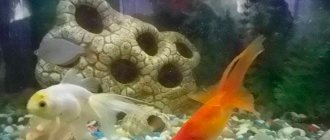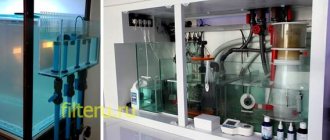A working aquarium filter is key to maintaining a healthy aquarium. Sometimes it happens that an aquarium filter stops working or does not work properly.
Sometimes the filtration system refuses to work or does not work properly. As a rule, deterioration in the performance of an aquarium filter leads to a decrease in the volume of pumped water and poorer cleaning, even if the filter is working.
In this article I will look at the problems and malfunctions that arise with aquarium filters and how to fix them. First, an excursion into what happens to the aquarium if the filter suddenly stops working or begins to work worse?
As already stated, good filtration is the basis for keeping an aquarium healthy. If the aquarium filter suddenly stops working, the following phenomena will appear in the aquarium:
- A jump in the concentration of toxins, nitrites and ammonia
- Decreased water quality and clarity
- Accumulation of waste and feed residues
- The fish become lethargic and disease outbreaks are possible.
- Algae appears
As you can see, the absence of a properly functioning filter leads to the complete destruction of the aquarium with its entire population over a long period of time. A small aquarium with a non-working filter dies much faster.
How should a compressor work in an aquarium?
in general, the compressor should work constantly to create a flow of water, if there is no filter that would mix the layers of water in the aquarium, and the larger the aquarium, the more intensively this must be done, otherwise the water in the aquarium will quickly turn sour from fish feces, and the water will need to be changed more often.
Interesting materials:
How to change the language on Facebook on your phone? How to change Facebook id from phone? How to change the picture in Steam from your phone? How to change the thumbnail in VK from your phone? How to change your phone number for Gmail? How to change the phone number to log into Tinkoff Bank? How to change the phone number to which the VKontakte page is linked? How to change mts phone number online? How to change your phone number for government services if you forgot your password? How to change your phone number on MTS?
Aquarium filter not working?
Let me start with the fact that I stepped on another “rake”. New. I escaped with a slight fright. Thanks to good theoretical training (and not only). As the title of my blog suggests, I in no way consider myself an expert in aquarium keeping. Still, I hope to teach you something.
Namely, don’t repeat my mistakes. It's funny, but as soon as I started writing these notes, I began to make all sorts of mistakes that I had not previously made. There is a good side to this: I gain experience, and you gain new knowledge. (My writing must be useful!) Order interior design in Minsk
Why do you think there is such a long boring introduction? “And I still can’t calm down after the stress I experienced.” The fact is that if I didn’t know how to correct the current situation (and I found out earlier, from articles that I strongly recommend you read before it’s too late), I easily and quickly destroy all the living creatures in my 100-liter bottle .
This is what happened. A week ago, I cleaned my largest aquarium as usual, rinsed the pre-filter sponges and did a 25% change. In order to wash the sponges, they need to be removed from the intake grids of underwater pumps.
So that none of the loaches, eleotris and shrimps are “sucked” into the filter through the grate, the pumps have to be turned off and temporarily removed from the water (so that the intake grates are out of the reach of my curious and enterprising pets).
After thoroughly washing the sponges, I pull them onto the grids, lower the pumps to their previous depth and turn them on. At the same time, air inevitably gets into the tubes and filter canisters. Since my canisters are located above the aquarium , I have to pump water for some time using a siphon.
Until all the air is out of the system. It looks something like the picture on the right.
Once all the air bubbles are out and the tubes are completely filled with water, I disconnect the siphon and attach the outlet tube of one of the filters to the flute, and insert a diffuser into the end of the other tube.
Now you can adjust the water flow and finish your weekly “water treatments”. That's how it was. And yet, there was some kind of glitch in the system, as it turned out later. Today I suddenly noticed that something in the aquarium was not as usual. This instinct is already appearing in me.
Because nothing catches your eye. (In fact, the instinct is still weak, in its infancy. Otherwise, I could have discovered the problem earlier.)
My flute is located under water and serves not for aeration (a diffuser is enough), but to distribute the second outgoing flow of water and create a small, uniform flow along the back wall of the aquarium. All this is intended to avoid the formation of stagnant zones.
So, as it turned out upon closer examination, the second filter did not work for me! — Air lock in front of the flute! When and why this plug formed and how long the filter did not work remains a mystery.
Probably, small air bubbles remained in the system and over time gathered in one place, forming one large bubble that blocked the flow of water. So, metaphorically speaking, my aqua was “breathing with one lung” for some time.
If I had not changed the water regularly and if there had been no live plants in the aquarium, things might have ended up much, much worse.
NOW IS THE MOST IMPORTANT THING.
If I had not previously read what happens to canister filters during a long power outage, I would have stupidly pumped the water in the system, released the air and would not have disconnected and washed the filter.
And I would hopelessly poison all my aquarium animals with what would splash out of the “stagnant” filter.
It would hardly have been possible to save anyone. Because about an hour after the power is turned off (and therefore the circulation of water in the canister stops), due to a lack of oxygen in the system, the beneficial bacteria that live in the filter and neutralize the aquarium water die.
If you then simply turn on the filter and allow it to “work” as if nothing had happened, the decaying “corpses” of bacteria will splash into the water and instantly make it uninhabitable. The larger the volume of the canister, the worse.
It’s good that I already knew this! Therefore, I was not at a loss, but urgently drew up a plan of rescue measures and began to implement it: 1) Rinse the “damaged” filter. 2) Rinse the prefilters. 3) Make a substitution of at least 30%.
MY ACTIONS
First, I attached a siphon to the problem tube and pumped the water, pouring it into a bucket. 20 liters. This allowed me to pre-rinse the filter. The first portion of water smelled disgustingly of hydrogen sulfide.
I felt nauseous. Can you imagine what would happen if all this nasty stuff got into the water?! — This is about 5 liters of concentrated poison at once, plus a long-term gradual leaching of decay products settled inside the fillers. - It's scary to think about! That's one thing.
Second: the temperature of the stagnant water in the canister was clearly more than 40 degrees. If this water got into the aquarium, the temperature would sharply rise by 3 degrees, no less. Up to 30 degrees, which in itself is not a gift for aquatic organisms.
It's not hydrogen sulfide, it's temperature shock! “It’s just great that I figured out how to drain the water into a bucket.” 20 liters was enough for the water flowing out of the filter to stop smelling. I turned off the filter and took it away for washing.
Next, I had to rinse the siphon and pump out another 10 liters of water, just from the aquarium. 5 liters of this water was intended to fill the filter canister after thoroughly rinsing the trays and fillers.
While washing the prefilters, I discovered that the sponge from the “damaged” filter was almost not dirty. That is, for several days now my 100-liter tank has been serviced by only one filter! “With such a large active population, this is not good.
I disassembled the filter and washed it quite quickly: I washed both canisters almost 3 months ago, so I didn’t find any special contamination (thanks to the pre-cleaning sponges).
However, I worked according to the “everyone died” scheme, that is, I washed the trays and fillers until they were clean, dripped special bacteria from a bottle , and then filled the canister with aquarium water. She put it in place, started the pump and pumped out the air from the system using a siphon.
At the same time, I disassembled and washed the flute, finding impressive mucus plugs in it (this was a discovery for me, don’t laugh!).
Oddly enough, I also found a positive side to what happened: now (if everything goes as it should) I don’t have to clean filter No. 2 until January 2015.
And one more thing: now I know when and in what order I will clean the filters. As it should be for the stability of the system - not both at the same time, but with a difference of 3 months. So we can say quite convincingly that everything is for the better)
In the process of cleaning the filter, I prepared water for changing (I brought cold water from the tap to the desired temperature, added warm water from the kettle and added AquaSafe conditioner (Tetra) 5 ml per 10 liters of water).
Only 3 buckets of 10 liters each. I poured them into the aquarium one by one. At the same time, I cleaned up the stretch and applied fertilizers ( ferropol from ZhBL and Tetra CO2 plus). After turning off the light I will add fishtamine. All.
This is an instructive story that happened to me today. I still can’t understand how I could allow such disgrace. However, anything can happen. Aquarium equipment suddenly breaks down, even new ones.
The electricity is turned off. Worries are piling up. Feeling worse. Attention wanders. Vigilance is lost. Anything can happen. The main thing is that it didn't get into trouble. The detected danger has been eliminated.
The moral here is: Stock up on knowledge in advance and learn from other people's mistakes. However, my mistake in this case is not obvious.
(Although, perhaps I didn’t remove the air from the system well enough. Or maybe it’s “sucking in” somewhere, I’ll keep an eye on it, because this happened for the first time.) You just need to keep in mind that anything can happen.
But I still did well, I didn’t get confused and acted quickly and competently, which I’m proud of) I wish you the same and thank you for your attention and patience to everyone who read this post to the end. I hope it was helpful. First of all, for those who still did not understand why an aquarium filter should work continuously and around the clock.
Mistake #3. Intense lighting
Choose the right lighting mode and brightness!
An aquarium illuminated almost around the clock looks very beautiful, but this can lead to various unpleasant consequences. Depending on the fish and plants selected, the daylight hours in the aquarium should usually not exceed 10 hours. If it continues for too long, bacteria and algae will begin to actively develop.
You should also install the aquarium correctly. It should be in a place where direct sunlight does not fall on it, otherwise the walls of the vessel will become overgrown with algae.
If there are no live plants in your aquarium, reduce the duration of lighting to a minimum, since the fish do not particularly need it. To control the length of daylight hours, you can use a timer that will turn the lighting equipment on and off at a given time.
Mistake #4. Changing water
Change the water once a week!
To keep the inhabitants and vegetation in your aquarium healthy, it is necessary to carry out water changes correctly. It is absolutely not necessary to completely change all the water in the container. It is enough to replace a quarter or a third of the aquarium volume every week.
To do this, you can use cold tap water, which must be allowed to stand for at least a day. A good solution is to use water conditioners, which will make your tap water suitable for your aquarium. If there are no living plants in the vessel, you can clean the soil with a siphon at the same time as changing the water.
And remember!
No matter how good the filter is, changing the water still remains a prerequisite for caring for the aquarium! By doing this, you get rid of the waste products of living inhabitants, and also saturate the water with nutrients necessary for microorganisms and plants.
the pump does not produce bubbles.
health. This is the second time I have encountered such a problem that the pump does not produce bubbles. 105 l aquarium, aquael fan2+ pump 450 l/h. I blew out the tube and cleaned it. Could there be a problem with the motor itself?
Check the pressure regulator. Wash the rotor and rotor chamber. Rinse the sponge well. Is there a result?
Modified 5.6.20 by gray13
health. This is the second time I have encountered such a problem that the pump does not produce bubbles. 105 l aquarium, aquael fan2+ pump 450 l/h. I blew out the tube and cleaned it. Could there be a problem with the motor itself?
The pump itself works - it pumps water, but there are no bubbles - is it understood correctly or what.
Well, if it is understood correctly, then there are two points here.
1. Over time, due to the weakness of the suction cups, the pump begins to slowly slide down the glass to the bottom, which leads to the fact that the pump does not have enough power to suck air through the tube.
What to do - change the Velcro rubber bands attached to the glass on the bracket where the pump is hung and attach the pump closer to the water cut. If the Velcro elastic bands are bad, it is stupid to periodically pull the pump up to the edge of the water after it slides down.
2. Where the air intake tube is attached to the pump, calcium deposits periodically form there, which blocks the air flow, the same can happen in the air tube.
What to do - clean the holes from calcium deposits with a needle, etc.
You can safely do without bubbles - after all, with them your whole lid is wet, right.
Source
Causes
This usually means that the air duct has become disconnected from the pump at some point or that the vibrator pump diaphragm has ruptured. In this case, you should definitely have another membrane in stock and replace it as soon as possible.
If the pump coil fails, you need to purchase a new pump. If you are using an airlift filter, this must be done urgently. Otherwise, it may be possible to increase aeration (this may be necessary, for example, if the fish show signs of hypoxia). You can use the diffuser included with the external filter, or if you don’t have one, any fine-hole tube will do. You can also raise the internal filter so that its outlet is above the surface of the water.
In case of emergency, if filtration is carried out using air flow, this flow can be provided in several ways:
• Fill an air mattress, inner tube, or similar with air and use it as an air reservoir. Then release the air slowly, using the clamp to regulate the air flow. If you don't have a clamp, a clothes hanger, twisted wire, etc. will work instead.
• Using a pump designed for inflating an air mattress or car tires, pump air through the filter system every hour for five minutes (this should be done both day and night).
What to do
Exaggeratedly speaking, all problems that arise with the performance of an aquarium filter can be divided into two conditional types:
- The filter doesn't work at all
- The filter is not working well
To understand the processes occurring inside the filter, I will start by describing and solving problems when the filter simply does not work well. As they say, poor suction or no suction, poor water pumping or few bubbles during aeration.
The causes of these defects are:
- Dirty filter
- Dirty and clogged filter media
- Clogged filter nozzle
- Clogged supply hoses
The described problems can be eliminated by thorough cleaning of the filter and components. Of course, the filter is first de-energized. The fillers are washed with running water at room temperature without the use of cleaning agents or replaced with new ones. Clean the impeller of the aquarium filter motor. Please note that the impeller should rotate without much effort.
The filter, tubes and fillers must be thoroughly cleaned, after which the filter is assembled and tested for functionality.
Filter does not work after cleaning
If the filter does not function properly after cleaning, it indicates a more serious problem with the filter motor and electrical circuitry. Most often, the reason for the filter not working after cleaning is incorrect assembly, even to the extent that the rotation of the filter motor is blocked by an incorrectly installed filler.











